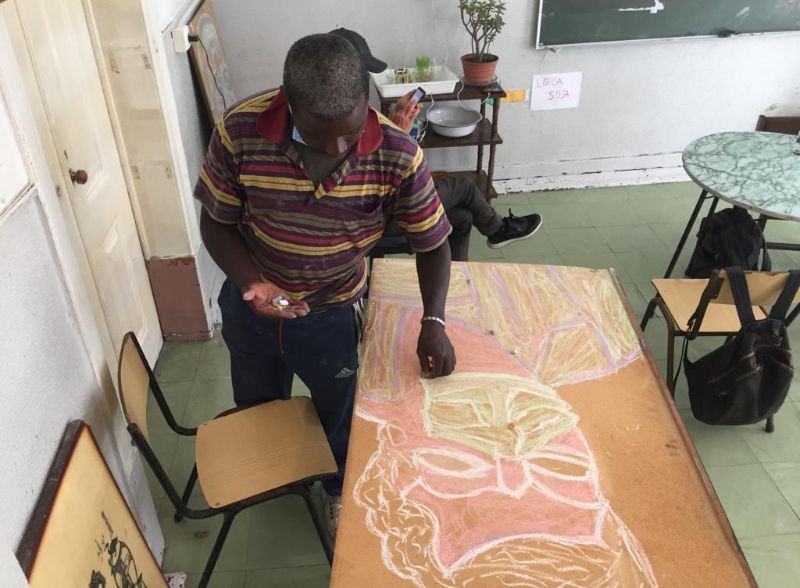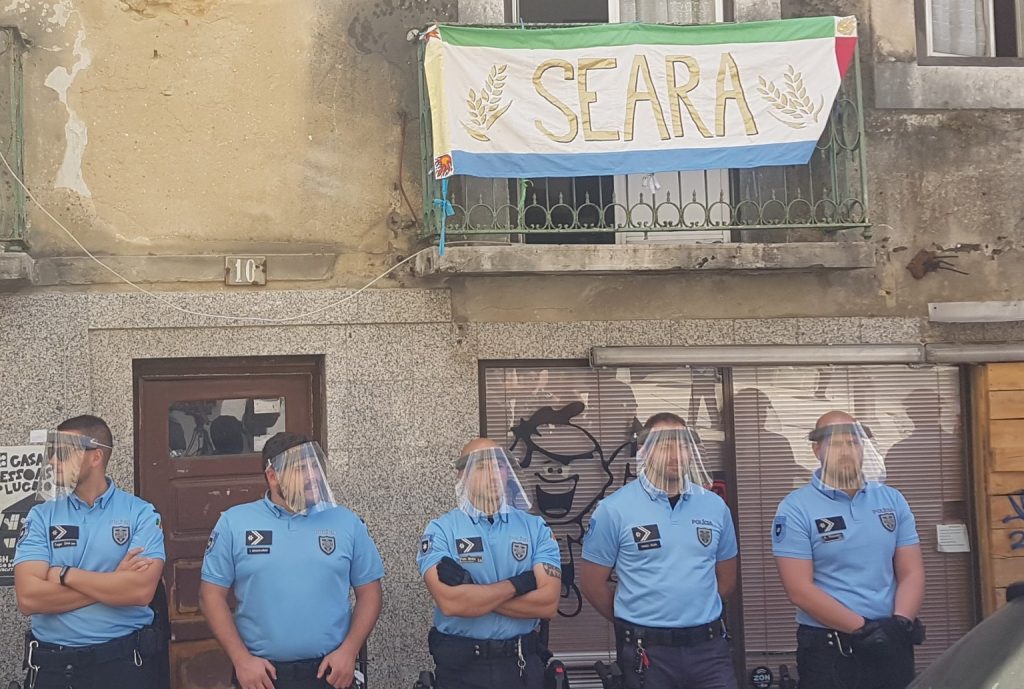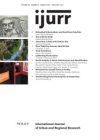On June 8, 2020 at 5am, private security guards carrying axes and hammers invaded a building in Lisbon’s Arroios district that had been occupied by a collective of activists and volunteers. After having previously been a community crèche with roots in an early 20th-century educational centre connected to the Republican movement, the building was now the property of an investment fund with plans to redevelop it for luxury apartments. However, the collective had transformed the space into a social centre where homeless or unemployed people and precarious workers could rest and have a shower, socialise, wash their clothes, charge their mobile phones and, in the case of a small group of homeless individuals, spend the night.
Seara, the social centre’s name, was the result of horizontal collaborations established by some 50 volunteers and neighbours at the height of the Covid-19 pandemic lockdown, as it became clear how vulnerable populations were being impacted by a deserted city with no services or people in the streets. The Seara members cleaned up and redid the space, brought in washing machines and then advertised the place to those who might be interested. Unsurprisingly, the response was positive, evidencing the vast number of people in need, in the area and beyond.
Seara is an example of a non-hierarchical mode of community organisation, professing a politics of care for those with whom we share urban space, and then acting on it. It was initiated by individuals connected to the pre-existing collective RdA Recreativa dos Anjos (who had set up a “solidarity canteen” to provide free meals to the area’s elderly and poor residents when the lockdown was announced), but also by others for whom this was their first activist and squatting experience. Seara members aimed to blur the boundaries between “provider” and “user”, reducing rules and conditionalities to access services and integrating the latter into weekly decision-making assemblies. It was a success. As one homeless person confided to one of the authors of this essay, “it’s impressive how a space without rules … is so well organised.”

Art activities at Seara, May 2020. Photo: Seara.
The initiative exemplifies what an urban politics of care might entail, the kind of urban politics some have suggested can arise from the solidarities knitted during the pandemic and that may hopefully last into the future. On the other hand, the invasion and the background against which it was carried out highlight the forces that will oppose such projects of care. In this case, they evidenced a compulsion to resume as quickly as possible the normal business of speculative urban redevelopment in a highly touristified city, disregarding legal constraints such as an existing moratorium on evictions.
An urban politics of care
An urban politics of care entails the modest but crucial initiatives that seek to rekindle the connections between different people in today’s cities, for instance between those who were able to stay at home during the lockdown and those who were not. In such initiatives, “help” is not commodified or constructed as an instrument of governing the urban poor. Rather, it is based on efforts to “common” resources and to pool energies in order to include vulnerable populations in how we imagine and reconstruct urban dwelling.
Seara’s appeal for the different groups drawn to it highlights three important elements. The first is the importance of a non-patronising mode of “care”, which was especially true for homeless people. Given its location in a district that, together with adjacent Anjos, has historically been where “vagrants” have clustered since the late 19th century – the city’s oldest soup kitchen and other organisations dedicated to the poor are located there – Seara could be considered redundant. Yet it was appealing precisely because it did not have the stringent rules those other organisations tend to have, along with queues, questions and stigma.
The second element is the ability of a politics of care to assemble different groups of people who might otherwise not encounter each other. The pandemic presented a new fact – the absence of “normal” city life – that had an impact on these groups. Homeless people need a functioning street life, with passers-by to beg for spare change and food, or to run errands for a little cash. Low-income immigrants working in restaurants suddenly lost their jobs. A third group of precarious (but more educated and politicised) workers initiated a process by which all three were integrated. To some extent this was a case of what we might term “squatting for others”. However, as the groups became acquainted, “care” became mutual support and a new collective emerged.
The third element is this type of initiative’s ability to identify specific needs based on local knowledge and to respond quickly to situations of crisis. Homelessness in Lisbon was highlighted by the UN Special Rapporteur for Housing in a country visit in 2016, and the President of the Republic has set up an agenda to end homelessness by 2023. Yet efforts to effectively address the situation seem to be lost as “broad strategies” are designed and “articulation” between the different official organisations is pursued. The inadequacy of the state and NGO response is compounded by the knowledge that the city currently has between 20,000 and 30,000 empty dwellings, previously used for tourism, while the homeless were directed to four sports pavilions. The situation is so frustrating that, on June 15, homeless people demonstrated in front of Parliament for the first time.
Back to business: illegal evictions and lack of state protection
The building’s owner, US-based Spark Capital, is one of a large number of transnational investment funds speculating on Lisbon’s built environment, mostly for short-term rentals or as “safe deposit boxes” for the rich. It must be noted that the invasion was illegal in three ways: First, by law all evictions must follow a court decision, and the collective was never shown any official documents permitting the eviction. Second, only the police is permitted to carry out evictions – the security guards and the owner’s lawyer who accompanied them were not allowed to do so autonomously. Finally, the declaration of the state of emergency following the Covid-19 outbreak included a moratorium on evictions until September 30, 2020. So what followed was unexpected.
After the security guards entered, threatening physical violence and brandishing a firearm towards one of the members, the latter called the police, who cordoned off the building. In the meantime, mobilisation was called for via Facebook and dozens of supporters quickly gathered at the scene. A standoff arose as people refused to disperse all day. At 6pm, riot police arrived. However, they came not to put an end to the illegal invasion and eviction, but instead to disperse those outside with pepper spray and batons. They allowed the private security guards and three Seara members who lived there permanently to stay. The Seara members opted to leave due to the hostility from the security guards, the absence of police protection and the fear of what might happen during the night. At midnight, the building was vacated and sealed with bricks.

Police cordon off the building, June 8. Photo: Seara.
The episode illustrates the tension present in cities that were facing the pressure of touristification or super-gentrification before the lockdown. They now have the opposite problem: they have seen revenues from tourism and associated jobs all but disappear (in Lisbon, overnight stays fell from 2.7 million in April 2019 to 54,000 in April 2020). In addition, sales of luxury real estate to foreign high-net-worth individuals (HNWIs) have come to a stop, affecting the sector within which the Seara building’s apartments were to be marketed. Uncertainty regarding the recovery of both sectors persists. In the meantime, powerful actors such as real-estate investment trusts (REITs) use all means to resume previous activities, including illegitimate ones: there is news of other cases where private guards were used to push through evictions during the lockdown. This tension will certainly materialise in variegated ways in different cities, at a small or larger scale, but the erasure of Seara may be a cautionary tale of things to come.
This small episode also encapsulates how particular mechanisms established for strategic reasons take on a life of their own. In this case, corporate investors benefited from the Lisbon City Council’s laissez-faire policy, designed to present a frictionless environment for their investments in the city’s built environment. Now, ignoring interim events such as the pandemic, these investors engage in actions that disregard the common good. Local and central governments need to protect initiatives of care: co-financing them, providing spaces where they can occur and producing an atmosphere of democracy in the city as a whole.
Some cities are already being reconstructed along robotic and automation lines. It is urgent to ask how we can also reconstruct them otherwise, in line with the common good. How can we make our cities sustain practices of care for those most afflicted by the effects of lockdowns, both during and after this period? How can we use the opportunity to reconfigure urban relationships to address both old and new vulnerabilities in a collective effort, as demonstrated by Seara?
Eduardo Ascensão is a researcher at Centro de Estudos Geográficos, University of Lisbon, with a focus on urban informality, housing and postcolonialism.
Nuno Rodrigues is a PhD candidate at the Institute of Geography and Spatial Planning, University of Lisbon, with research on platform urbanism.
Related IJURR articles
De Moor, J. (2016). Practicing openness: Investigating the role of everyday decision making in the production of squatted space. International Journal of Urban and Regional Research, 40(2), 410-424.
Di Feliciantonio, C. (2017). Spaces of the expelled as spaces of the urban commons? Analysing the re‐emergence of squatting initiatives in Rome. International Journal of Urban and Regional Research, 41(5), 708-725.
Lestegás, I. (2019). Lisbon After the Crisis: From Credit‐fuelled Suburbanization to Tourist‐driven Gentrification. International Journal of Urban and Regional Research, 43(4), 705-723.
